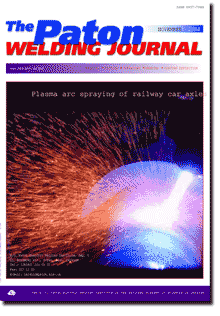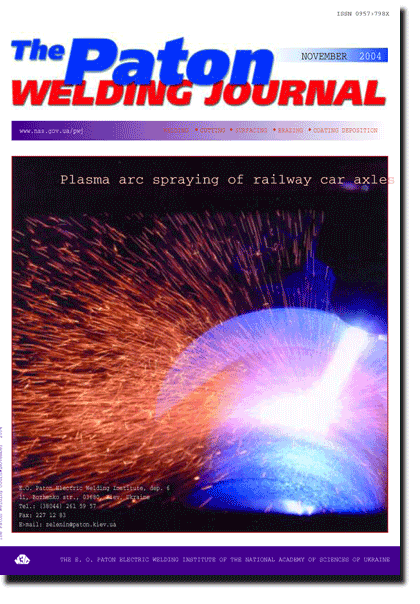

| SCIENTIFIC AND TECHNICAL | |
| Kuchuk-Yatsenko V.S., Shvets V.I., Chvertko P.N., Gordan G.N., Sakhatsky A.G. and Remenyak I.P. Flash-butt welding of dispersion-hardened copper alloy of Cu--Al2O3 system | 2 |
| Technological process of flash-butt welding of dispersion-hardened copper alloy AL-25 (C 15725) with a forced joint formation is considered. Data of metallographic and X-ray spectral microanalysis of microstructure and results of mechanical tests of welded joints are given. | |
| Markashova L.I., Chvertko P.N., Remenyak I.P., Polovetsky E.V. and Alekseenko T.A. Peculiarities of formation of structure of steel to aluminium joints in flash-butt welding | 5 |
| Considered are principles of formation of structure and phase composition of steel to aluminium joints made by flash-butt welding. It is shown that phase composition affects performance and mechanical properties of the joints. | |
| Pismenny A.S., Pentegov I.V., Stemkovsky E.P., Shejkovsky D.A. and Kislitsyn V.M. Calculation of modes of magnetic-pulse welding | 13 |
| A method is proposed to calculate the modes of magnetic-pulse welding, which combines the analytical method of calculation and numerical methods, using a PC. Application of this method allows calculation of magnetic-pulse welding parameters and selecting the optimum welding modes with an accuracy sufficient for practical purposes. | |
| Astakhov E.A. Anti-friction properties and corrosion resistance of Al2O3 detonation coatings used in marine engineering | 17 |
| The paper gives results of anti-friction and corrosion tests of the detonation coatings of Al2O3 in similar combination and in pair with high-tin bronze in water, including with an addition of grease lubricant, as well as results of long-time comparative tests of the above coatings in pair with caprolon. A satisfactory performance of samples simulating operation of bearings of the support assembly of rudder spindle is proved. | |
| INDUSTRIAL | |
| Paton B.E. and Bondarev A.A. State-of-the-art and advanced technologies of electron beam welding of structures | 20 |
| The paper describes a number of ingenious technological developments made by specialists of the E.O.Paton Electric Welding Institute during the period from 1969 to 2003. Advantages of electron beam welding process are shown by an example of specific structural materials. Recommendations on design of a welding process under industrial enterprise conditions are given. Examples of new technological developments, including welding of high-strength aluminium alloys alloyed with lithium and scandium, welding of dissimilar and composite materials, are described. | |
| Zamkov V.N., Vrzhizhevsky E.L., Topolsky V.F. and Petrichenko I.K. Effect of halide fluxes on porosity of EB welds in titanium alloy VT6 | 28 |
| Application of halide flux in EBW of titanium alloy allows reducing porosity of the weld metal by an order of magnitude. | |
| Korzh V.N. and Popil Yu.S. Influence of hydrocarbon additives on the structure of hydrogen-oxygen flame and temperature distribution along the plume length | 32 |
| Boundaries are determined for transition from the laminar to turbulent mode of combustion product flow in a mixture produced by water electrolyses generators, depending on additives of vapours of hydrocarbon compounds to a mixture. Considered is temperature distribution along the plume length for different modes of the flow of a jet of combustion products and additives of hydrocarbon compound vapours to the mixture. Conditions of the possible use of the hydrogen-oxygen flame are described. | |
| Valits K.A. and Pasechnik S.Yu. Increase in sensitivity of deposited steel 110G13L to strain hardening | 37 |
| It is shown that electroslag cladding of high-manganese steel 110G13L provides substantial increase in steel sensitivity to strain hardening, in addition to restoration of geometry and improvement of performance of parts, which leads to increase in wear resistance of metal and extension of service life of parts. | |
| Zhadkevich A.M. History of origination, technological features and technical capabilities of the first methods of soldering and brazing | 39 |
| Retrospective review of development of brazing technique in manufacturing bronze, gold and silver items by the ancient and medieval craftsmen is given. Technology of brazing the intricate tin items is described. It is noted that the heat source was hearth furnaces with an air blowing through a tube, and the composition of fluxes included metallic powders of metals, carbonates and nitrides. Composition of brazing alloys was selected from the condition of a minimum temperature of eutectic transformation and similar color and glitter as that of the metal brazed. | |
| Popov S.N. and Antonyuk D.A. Prospects of application of new methods of distance education of enginnering personnel in welding industry | 45 |
| Main methods of organizing the technology of distance education of engineering personnel in welding industry are presented. The statistic data are given and prospects of implementation of these technologies at the Chair of Equipment and Technology of Welding of the Zaporozhie National Technical University (ZNTU) are shown. | |
| BRIEF INFORMATION | |
| Ryzhov R.N., Kozhukhar V.A., Maksimov S.Yu. and Prilipko E.A. Application of external electromagnetic actions for improvement of mechanical properties of welds in underwater wet welding | 49 |
| Optimization of conditions of external electromagnetic actions for conditions of underwater wet welding was realized on the basis of analysis of experimental dependencies of mechanical properties of welds on induction of controlling magnetic field. | |
| Thesis for the Doctor of Technical Sciences degree | 52 |
(You are viewing the simplified file contents)
The cost of subscription/purchase order journals or individual articles
| Journal/Currency | Annual Set | 1 issue printed |
1 issue |
one article |
| TPWJ/USD | 384 $ | 32 $ | 26 $ | 13 $ |
| TPWJ/EUR | 348 € | 29 € | 24 € | 12 € |
| TPWJ/UAH | 7200 UAH | 600 UAH | 600 UAH | 280 UAH |
| AS/UAH | 1800 UAH | 300 UAH | 300 UAH | 150 UAH |
| AS/USD | 192 $ | 32 $ | 26 $ | 13 $ |
| AS/EUR | 180 € | 30 € | 25 € | 12 € |
| SEM/UAH | 1200 UAH | 300 UAH | 300 UAH | 150 UAH |
| SEM/USD | 128 $ | 32 $ | 26 $ | 13 $ |
| SEM/EUR | 120 € | 30 € | 25 € | 12 € |
| TDNK/UAH | 1200 UAH | 300 UAH | 300 UAH | 150 UAH |
| TDNK/USD | 128 $ | 32 $ | 26 $ | 13 $ |
| TDNK/EUR | 120 € | 30 € | 25 € | 15 € |
AS = «Automatic Welding» - 6 issues per year;
TPWJ = «PATON WELDING JOURNAL» - 12 issues per year;
SEM = «Electrometallurgy Today» - 4 issues per year;
TDNK = «Technical Diagnostics and Non-Destructive Testing» - 4 issues per year.


